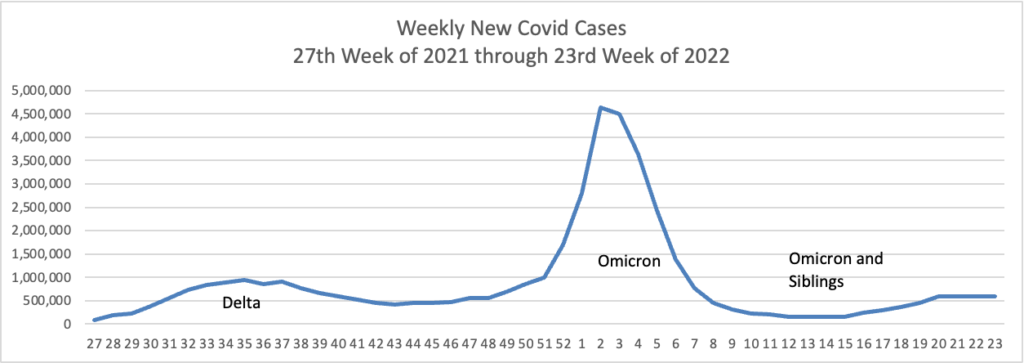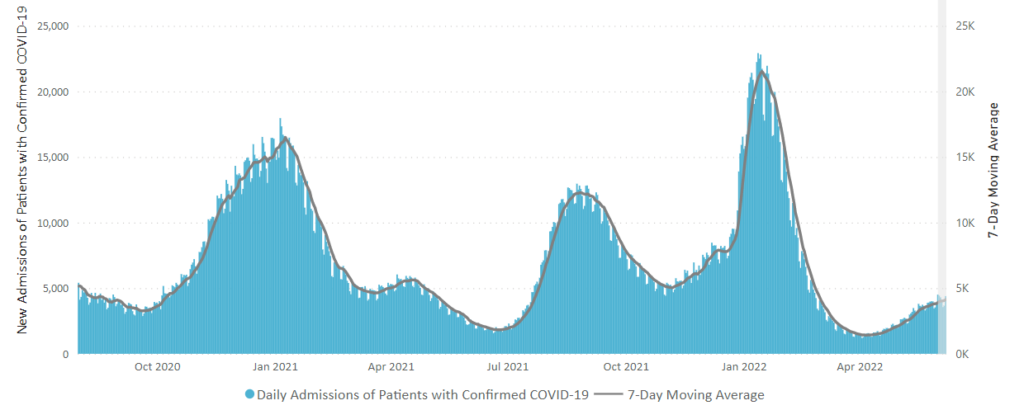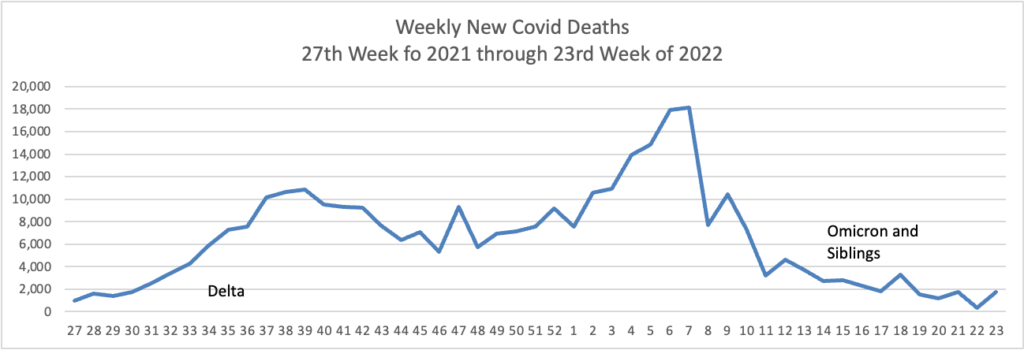Based on the Centers for Disease Control’s Covid Data Tracker and using Thursday as the first day of the week, here is the FEHBlog’s weekly chart of new Covid cases from the 27th week of 2021 through the 23rd week of 2022.

The CDC’s weekly review of its Covid statistics observes “As of June 8, 2022, the current 7-day moving average of daily new cases (109,032) increased 8.0% compared with the previous 7-day moving average (100,916).”
Here’s is the CDC’s latest weekly report of new Covid hospitalizations:

The CDC’s weekly review notes “The current 7-day daily average for June 1–7, 2022, was 4,127. This is an 8.0% increase from the prior 7-day average (3,820) from May 25–31, 2022.”
Here’s the FEHBlog’s weekly chart of new Covid deaths over the same period as new cases:

The CDC’s weekly review adds “The current 7-day moving average of new deaths (306) has increased 18.6% compared with the previous 7-day moving average (258).” Over 2/3s of the U.S. population is now fully vaccinated.
Here’s the FEHBlog weekly chart of Covid vaccinations distributed and administered from the beginning of the vaccination era at the 51st week of 2020 through the 23rd week of 2022:

The CDC’s weekly review states “As of June 8, 2022, the 7-day average number of administered vaccine doses reported (by date of CDC report) to CDC per day was 290,078, a 15.6% decrease from the previous week.”
The American Hospital Administration adds
An initial 10 million doses of COVID-19 vaccine are available for children under age 5 if the Food and Drug Administration authorizes and the Centers for Disease Control and Prevention recommends the Pfizer and Moderna vaccines for children in this age group, Assistant Secretary for Preparedness and Response Dawn O’Connell said yesterday during a White House briefing.
FDA’s vaccine advisory committee will meet June 14-15 and the CDC’s advisory committee June 17-18 to consider whether to authorize and recommend the vaccines for this age group, after which the agencies will issue their respective decisions.
“It will take some time to position these vaccines across the country, and vaccinations can’t begin until CDC has made its decision,” O’Connell said. “But we also know that many parents have been waiting for a long time, so we will be working 24/7 until every dose is shipped and delivered.”
The Administration last week opened pre-ordering of doses for states, tribes, territories and other partners, and estimates that 85% of children under 5 live within 5 miles of a potential vaccination site, she said.
The CDC’s weekly review sums things up as follows:
As of June 9, 2022, there are 314 (9.75%) counties, districts, or territories with a high COVID-19 Community Level, 1,052 (32.67%) counties with a medium Community Level, and 1,854 (57.58%) counties with a low Community Level. This represents a small (+2.20 percentage points) increase in the number of high-level counties, a moderate (+9.57 percentage points) increase in the number of medium-level counties, and a corresponding (−11.77 percentage points) decrease in the number of low-level counties. Fifty-two (100%) of 52 jurisdictions* had high- or medium-level counties this week.
To check your COVID-19 Community Level, visit COVID Data Tracker. To learn which prevention measures are recommended based on your COVID-19 Community Level, visit COVID-19 Community Level and COVID-19 Prevention.
From the unusual viruses front, the American Hospital Association tells us
The Centers for Disease Control and Prevention today reported over 1,300 monkeypox cases globally, including 45 in the United States. While no deaths have been reported and the overall risk to the U.S. public remains low, officials encouraged clinicians to review the CDC’s latest guidance and individuals to talk with their health care provider if they develop symptoms or need to get tested.
According to CDC, monkeypox spreads through direct contact with an infected person’s body fluids, sores or materials that have touched them, such as clothing or linens. It may also spread through respiratory secretions when people have close, face-to-face contact.
Smallpox vaccines are effective at protecting people against monkeypox when given before exposure and may also help prevent the disease or make it less severe. According to CDC, the Strategic National Stockpile currently holds about 72,000 doses of JYNNEOS smallpox vaccine and will soon receive an additional 300,000 doses from the manufacturer. The U.S. also has ordered another 500,000 doses for delivery later this year. In addition, the SNS holds over 100 million doses of an older smallpox vaccine (ACAM2000).
From the electronic health record front, Beckers Hospital News reports
Oracle’s primary mission is improving the complex healthcare system with technology, according to Larry Ellison.
The chair, co-founder and chief technology officer of Oracle said in a June 9 virtual public presentation the company plans to vastly improve care delivery, outcomes and public health policy while also lowering costs. Oracle acquired Cerner in a $28.4 billion transaction earlier this week and has plans to modernize the platform, taking it from a documentation and billing system to a complete source of information about an individual’s healthcare. The EHR would also have virtual care capabilities, be interoperable and expand clinical trial accessibility.
“Together, Cerner and Oracle have all the technology required to build a revolutionary new health management information system in the cloud,” Mr. Ellison said. “That system will deliver much better information to healthcare professionals. Better information will fundamentally transform healthcare.”
Oracle aims to build a unified database for patient information, similar to the unified financial database with credit information, accessible to healthcare providers and public health officials. The database would have anonymized data from hospitals, clinics and providers across the U.S. and provide up-to-the-minute information about patients’ personal health as well as public health statistics, such as the number of people hospitalized with COVID-19 or available hospital beds in a particular state.
“We’re building a system where the health records, all American citizens’ health records, not only exist at the hospital level, but they are all in a unified national healthcare database,” Mr. Ellison said. “The national database solves the data electronic health record fragmentation problem.”
Aim high. Assuming security and privacy challenges can be addressed, such a database could be a public health game changer.
